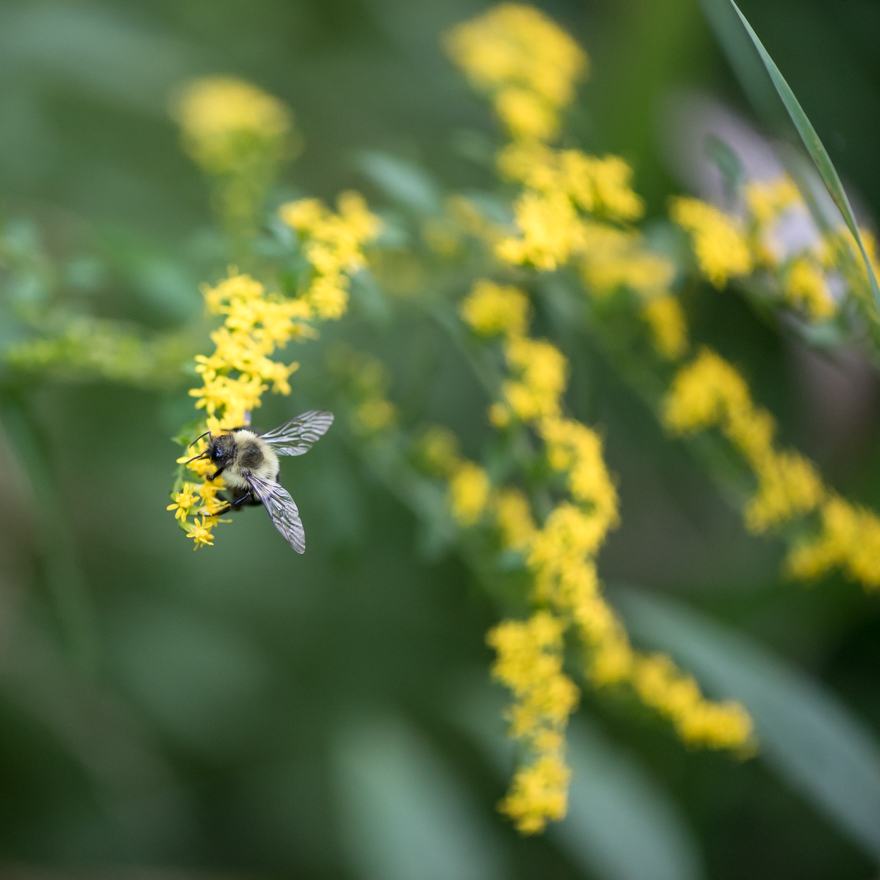
No story — late summer is its own justification.
Tagged: Blue Hills Reservation, bumblebee, Fowl Meadow, Goldenrod

No story — late summer is its own justification.
Tagged: Blue Hills Reservation, bumblebee, Fowl Meadow, Goldenrod
I have been neglectful of maintaining my yard this summer, and the jungle is encroaching. My neighbors haven’t staged an intervention yet, but I’m sure it’s coming. And while I feel somewhat guilty that I’m probably making it harder for my favorite neighbor to sell her house, it’s pretty entertaining to watch things grow. And when something really cool turns up like it did yesterday, my rationalization goes into overdrive, and my neglect feels momentarily justified. This is my latest excuse, found yesterday afternoon when I was getting out of the car:
These are aphids parasitizing a burdock plant, while simultaneously being tended by ants. I’d read about this phenomenon, but never seen it in person. Aphids are small insects that suck juices from plants, and for this they are mostly disliked by gardeners and farmers. But ants have a different view on the matter, finding opportunity where others see only a pest. When aphids feed on plant juices, they are primarily interested in extracting proteins, which tend to be in very dilute solution. As a result, they have to process a lot of sap, and they excrete sweet sap concentrate from their back ends; some ant species find this excretion delicious and nutritious, and go to great lengths to maintain access to it. In a symbiotic relationship, the ants protect the aphids from predators (like ladybug), and carry aphids to ideal plant targets to ensure that they eat well. In exchange, the aphids excrete (poop) sweet sticky liquid when ants stroke their abdomens.
Tagged: Ant, aphid, Aphis fabae, Arctium lappa, burdock, Formica, parasitism, symbiosis, urban agriculture
In my life as a carpenter, most projects start with some kind of demolition, and friends inevitably ask me what kinds of things we find in old buildings. I think they’re mostly imagining that I have a story about a cookie tin full of old silver dollars. I don’t, and the one diamond ring I found I felt obligated to return to the homeowners. It turned out that it wasn’t theirs, but they kept it anyhow. No one lays claim, though, when we encounter the remains of animals that share our homes. We find our share of desiccated mice and squirrels, but sometimes something really cool turns up. I found this cigar-like object as we were removing cedar shingles from an exterior…
Tagged: diamond, found treasures, leafcutter bee, Megachile, nest, ring, shingles
I am a bird guy. I started paying careful attention to them when I was about 7 years old, the way other kids fixate on dinosaurs. As a consequence, I can generally identify any bird I hear or see in New England, and if I can’t, I have a pretty good idea where to look in the bird book to find out. Like that kid and his dinosaurs, though, my knowledge thins rapidly as I leave my area of specialization. Other warm-blooded vertebrates I can sort of fake, but insects — I’m totally at sea.
So a few days ago when I was running with the pups in Cutler Park, I was very puzzled to see a large clearing filled with thousands of small mounds, each with a hole in the center. My first thought was ants, and I even spent a few minutes in the evening drizzle looking for some. It didn’t occur to me that the holes in the mounds, about the size of my little finger, would imply ants big enough to cause years of nightmares.
My cluelessness, however, is generally balanced by curiosity, so I returned the next day. It was warm and sunny now, and the extent of the mounds had increased noticeably.

And the warmer weather brought a dramatic increase in activity.
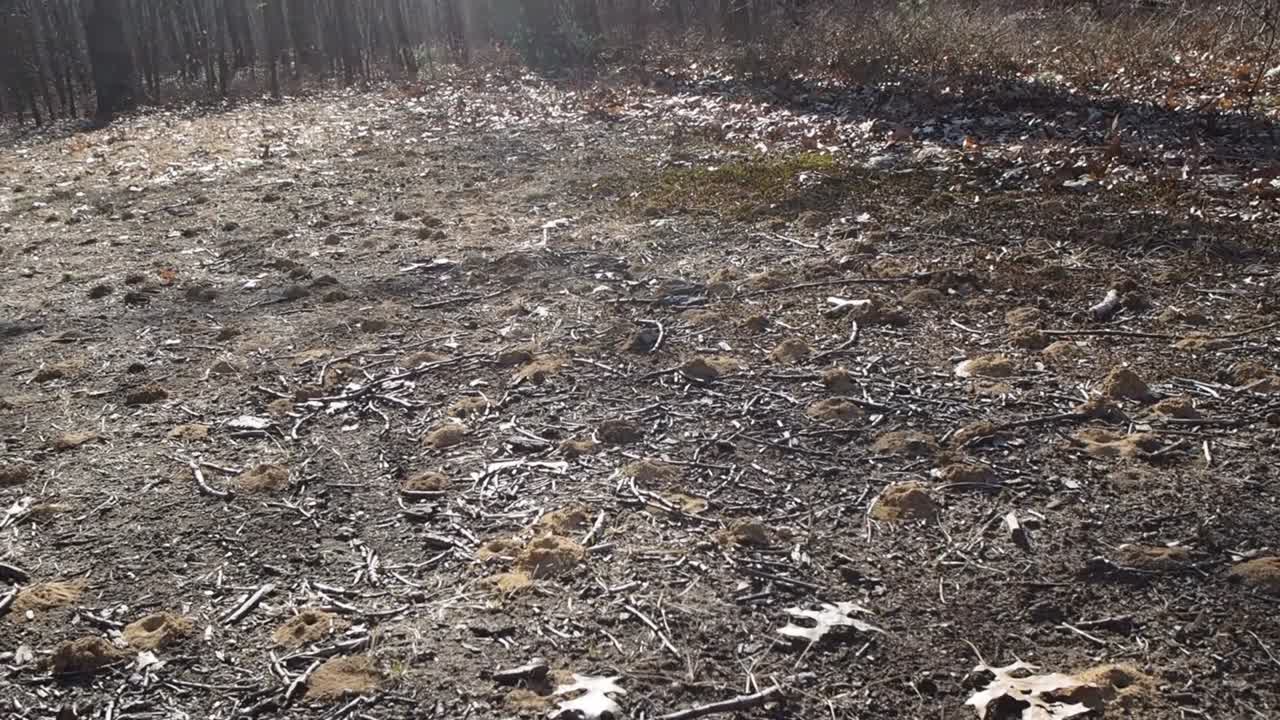
They were bees, not ants! The holes in the mounds suddenly made more sense.
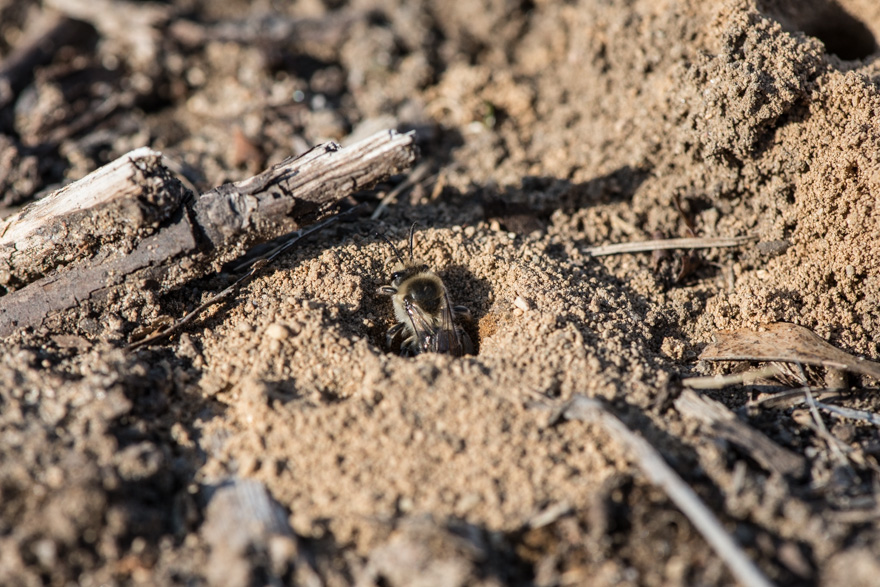
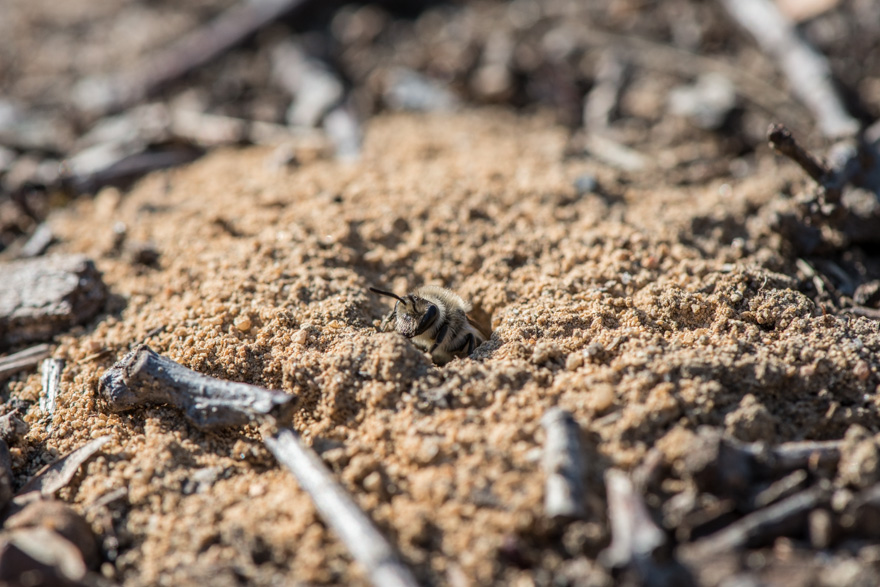
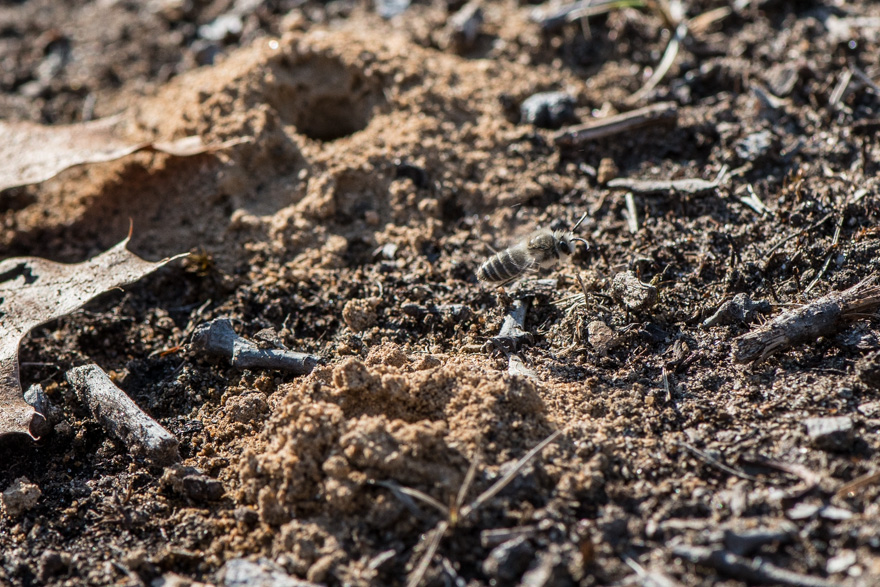
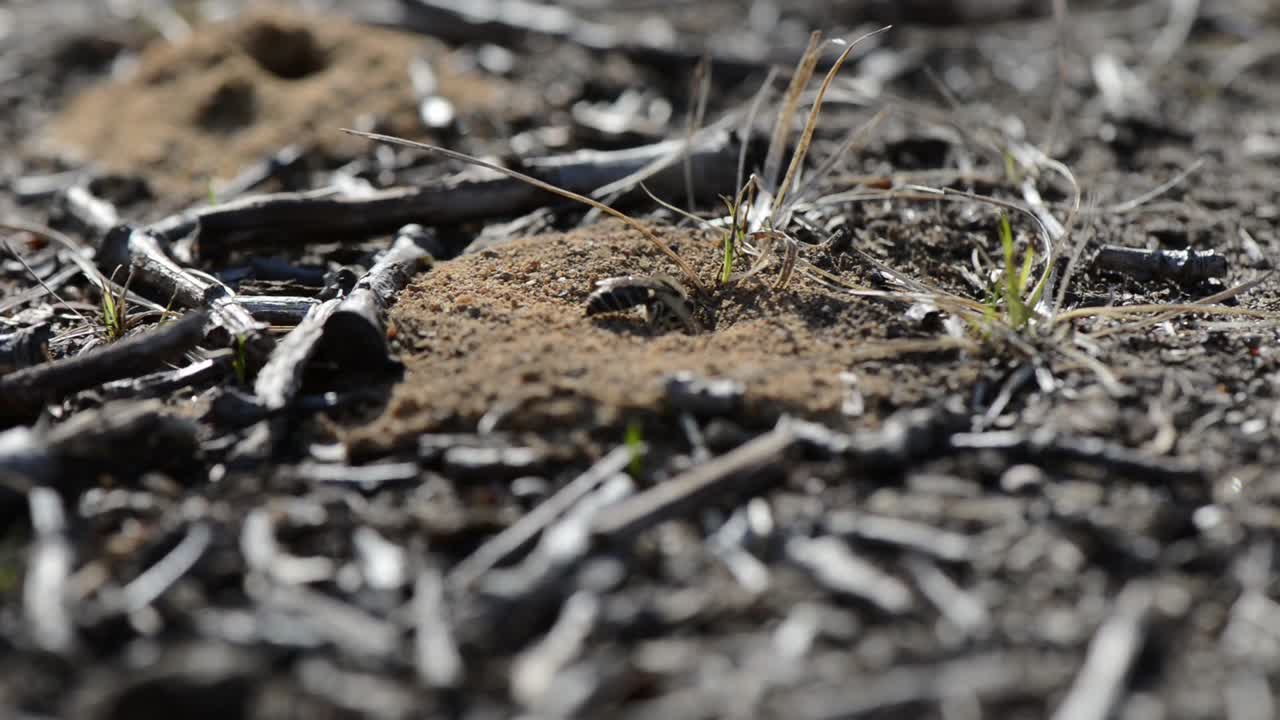
But now I had a bee identification challenge. The critters at Cutler didn’t look particularly like honeybees, as they weren’t yellow enough, and they didn’t seem to have any inclination to sting me in spite of my intrusions. The large area covered by the mounds — now more than 60m x 20m –seemed like an important clue. I’d found some unfamiliar beetles hanging around with the bees, so I photographed them as well, in case they were relevant.
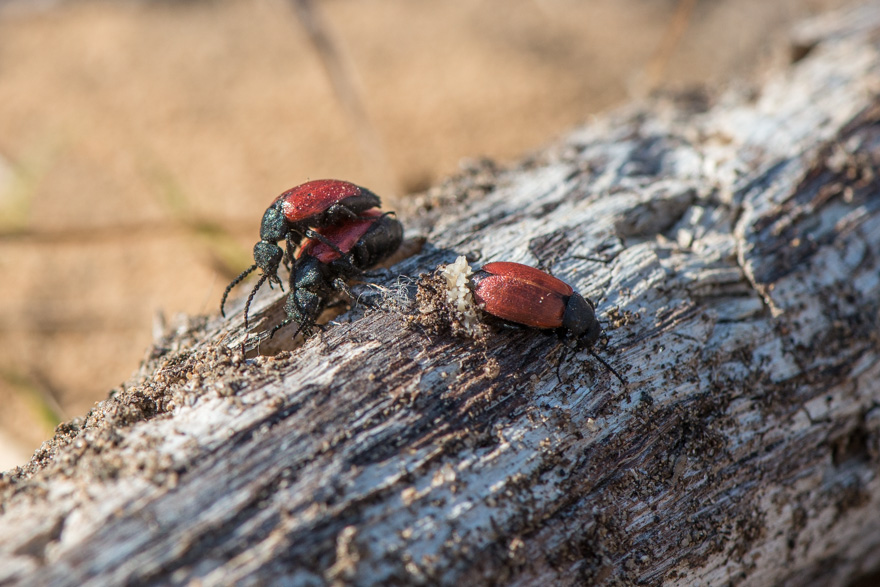
Whenever I encounter a puzzling arthropod, my first recourse is to email my friend Jenn Forman Orth. By profession, Jenn is an invasive plant ecologist, but she’s the closest thing to an entomologist I’ve got, and she’s never let me down. She suggested that the Cutler bees were either Andrenidae or Colletidae, as both are families of solitary, ground-nesting bees that emerge in the spring; the trouble is that Colletes and Andrena bees look very similar. But the beetles turned out to be very informative: they are Tricrania sanguipennis, blister beetles that specialize in parasitizing bees of the genus Colletes. Other bug-inclined friends also weighed in, suggesting that Colletes were much more likely to nest in large aggregations like the one I’d found. And my friend Tom Palmer, an extraordinary naturalist with a passion for snakes, told me that he has seen Tricrania beetles regularly, but only in association with Colletes bees.
So here’s what I think I’ve figured out about these guys: The bees are likely to be of the genus Colletes, known as cellophane or polyester bees because of a plasticky excretion with which they coat the inside of their burrows, and the species may be inaequalis. In the world of birds, ambiguous IDs are very uncommon, but I’m discovering that ambiguity is the rule with insects. The bees are solitary, in that every female is fertile, and each one lays eggs in her own burrow, but large aggregations of closely spaced burrows are common for this genus. This particular aggregation covers nearly 1/4 acre and contains thousands of burrows.
The bees lay their eggs into burrows that they have stocked with honey and pollen, and then I believe they die. The eggs hatch in the burrow, and the bees develop for 11 months until they emerge the following spring — the event that I’ve been observing. They spend about a month gathering pollen, preparing a burrow for eggs, and mating; I don’t know if they reuse previous burrows or start from scratch each year. So much I don’t know!
The Tricrania beetles’ life history is tightly connected with that of the bees. The adult beetles emerge from burrows in the spring at the same time as the adult bees, and the beetles promptly mate, lay eggs, and die. The photo above seems to catch them at mating and egg-laying. The eggs hatch 3-4 weeks later, and the larvae grab onto the leg hairs of the male Colletes bees. When the male bees mate with the females, the beetle larvae transfer themselves to the backs of the females, and thus score a free ride into the egg chamber of the burrow, where they disembark. Once the adult bee lays eggs and leaves the burrow, the beetle larvae first eat the bee eggs, and then, in the course of 8 metamorphic transformations, nourish themselves on the food the bee has cached in the burrow. Adult beetles emerge in the spring at the same time as bees in surrounding burrows, and the fun begins again.
In the course of my investigations into these creatures, I found some fantastic sources of information:
Tagged: bees, beetle, Colletes, Cutler Park, insects, parasitoid, Tricrania